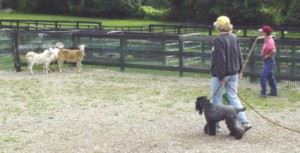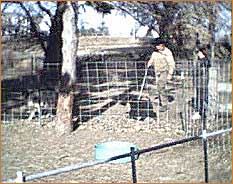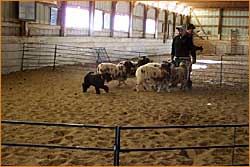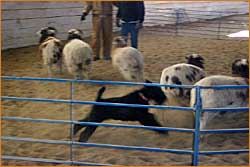Notes on a First-time Herding Clinic Experience
My husband, who’s an actor and a pretty funny guy, teased me and said, in effect, “You’ll be sorry! I expect major vet bills for ‘damaged livestock.’” In my heart of hearts I thought he might be right, but I forged ahead with my plan to test Dodger’s shepherding abilities against his prey instinct. On Saturday morning, August 7th, just before the alarm was set to go off at 4 a.m., Dodger and I crept quietly out of bed and went downstairs (Bill had a major golf tournament that day and I didn’t want to disrupt his timetable). We both had a little breakfast, a short walk and were on our way by a bit after 5. After only one wrong turn, we arrived at the mountaintop estate just west of the Connecticut border, where the clinic was to begin at 8 a.m. The moment we arrived, I was afraid I’d made a big mistake. The 10 dogs registered for the clinic were predominantly the well-known herding breeds – Border Collies, Australian Shepherds – with a Briard, Belgian Malinois, Greater Swiss Mountain Dog – and Dodger. The trainer, Tenley Dexter, gathered all the owners in one of the barns for some preliminary information. The very first thing she said was that “barking dogs would absolutely not be tolerated,” that if you put your mind to it, you’d be amazed at how well you could discipline your dog. Of course, Dodger was in our van – barking. I posted myself by the barn door so that I could periodically go back to the car and tell him, as firmly as I ever have, to KEEP QUIET. He kind of listened.
At about 9:30 we all went outside so that Tenley could begin working with the dogs and their owners. Eight of the dogs were novices, but Dodger was the only first-time participant. I was happy that we had been assigned slot #7, so that I’d have time to do a lot of observing before it was our turn in the pen. Then we moved to the area beside the pens, and I took Dodger out of the car so that he would have time to acclimate himself to all the other dogs and settle down a bit before he was called. He adjusted quickly and even though there were lots of new dogs to check out, he actually seemed to be interested in what was going on inside the pen. The format of training was that each owner and dog first worked together on the basic commands: “Get around” – which meant taking your dog around the inside perimeter of the Finally, it was our turn. Dodger, who thinks that everything in life is fun, entered the pen with aplomb. As was her custom, Tenley spoke not only to the owner in question, but also to the onlookers, remarking that she’d never worked with a Kerry, and since he was a “Terrier” I gathered that she wasn’t sure what to expect. She put us through the paces I’d already observed and Dodger was doing what he was supposed to. I had to be corrected a few times because I was jerking the lead instead of using the rake to indicate when I wanted him to stop. (She explained that she uses a very lightweight plastic rake, instead of a pole, on novice dogs because it’s much easier for them to see and more effective.) But all in all, things were going well and my confidence in myself and in Dodger was improving. I began to think, “This might be fun!”
The last two dogs she worked were veteran herders and they did some impressive maneuvers, which awed everyone. I couldn’t imagine getting a dog to that point, and when I learned that each had been at this about five years, I don’t know whether I was reassured or discouraged! Eventually, we all took a lunch break and then during the afternoon everyone was given another 20 minutes in the pen. We were told that the dog’s second turn would be quite different – that now they knew what to expect. Dodger was no exception and Tenley remarked that he was really interested! This time she pushed him a little harder to see how obedient he would be – and that’s when the Terrier in him surfaced! Eventually though, he acquiesced to her desires and followed her commands. As we left the pen, she told me that if I wanted to pursue this I’d have a lot of fun with him. “You can see,” she said, “that he loved very minute of it.” It’s true. He did. I don’t think I’ve ever seen him have more fun. All in all it was a great day. Everyone there was most cordial and they all thought Dodger was really cute (he was!). That was nice, because I was afraid that there might be some sort of “writing him off” because he wasn’t one of the “officially recognized” herding breeds. But he did himself – and Kerries in general – proud. We arrived back in Delhi around 8 p.m., tired, but pleased. I’d definitely try it again. Devil the Kerry Blue Heeler
We like to keep our dogs very active in something, and it was hard giving Devil her time for fun. She and Kisses visit nursing homes monthly, which the girls and I enjoy, but I still felt that she wanted another job to do. In watching Devil play in the backyard with Kisses, children and other dogs, I noticed that she was very persistent in herding dogs and children alike, to where she wanted them to go. My husband and I decided to bring Devil to a herding clinic after attending Patricia Trotter’s “Born to Win” seminar, where she really emphasized that form should follow function. A friend in our local Kennel club, who has Australian Cattle Dogs, asked us if we were interested in attending a herding clinic that John Holman (an all-breed herding dog trainer) was facilitating. This gave me the opportunity to show that the Kerry Blue Terrier still has the natural instinct to herd, and is not just a crazy Terrier. So my husband, Kari and I headed down with our friend Dawn to the Omaha, Nebraska area to put Devil to the test. We arrived that morning unloaded the dogs and then headed over to the outside pens where everyone was standing while a woman was working a Border Collie in a large pen of sheep. Everyone gazed at us in wonderment, not knowing what breed we were thinking would be able to do the task. We all smiled and stood in confidence, looking like we knew what we were doing. While watching, we witnessed a correction to the dog in the pen, which was harsher than what we are accustomed. Our mouths hit the ground. Could our sensitive Kerry Blue Terrier withstand this harsh of a correction? Devil is like all other Kerries, fierce and a true terrier when pursuing vermin, but is eager to please us, therefore doesn’t need much of a correction when she makes a mistake. Shrugging it off we decided we would give it a try, and if it was too hard on her, we would simply pull her out of the situation explaining that this wasn’t for us after all. Knowing that, we did something that many dream about but never get the chance to do. The beginning dogs work in a small round pen, about 20 feet by 20 feet. The more advanced dogs go into the large pens. Each dog is given about two twenty minute runs individually with the owner and John, the trainer. Devil watched the other dogs work the sheep with much excitement. John looked to Devil and I and asked how old she was, as he thought she was a Bouvier puppy. We explained that she was a Kerry Blue Terrier, and that they were originally bred as an all around farm dog. John then spoke to everyone explaining what we should expect from a dog her age, that she should not be as easily distracted as the younger dogs were. He said, “Let’s bring the Kerry Blue Heeler in!” John starts all the beginning dogs on their leash letting them follow the sheep around. There were five sheep, John, Devil and myself in the pen. John holds you by the arm to keep you out of the way of the sheep and dog. He did an excellent job explaining what she was doing while he worked her. When we took her off the lead and told her to “get them”, she immediately went to the opposite part of the pen, “pottied” and did not appear to be interested in the slightest. We kept encouraging her, and she kept walking around doing her investigating business, completely tuning out the fact that there were five sheep in the pen with her. You would have thought they were an everyday fixture at our house. So, John walked up to one of the sheep and grabbed them by the hind leg to see if this would spark Devil. The herding instinct kicked in! It was like a light came on, and she had been doing this all her life. She was beautiful moving them around the pen. She was very proud of herself, prancing and giving an occasional bark to keep a disorderly one in line. She responded well to John’s light tap to the ground with his fiberglass pole, which he used to shift her direction. John explained that you should focus on encouraging their drive, when it is your dog’s first time, giving very few corrections. Our first session was a success and the other owners also applauded her. Right after the session, he explained to me that she definitely has the drive and lots of potential. John explained he was ready to call it quits when we first walked in, and she ignored the sheep. Kari, my husband and I were just beaming, and everyone with the herding breeds was commenting on how awesome she looked out there. Now we had to sit and painfully wait for our 2nd run. We had to put Devil back in the van to wait for her turn again, because she was too noisy (she wanted those sheep) and was distracting the other dogs. Our second run was far better than the first. We watched everyone in front of us go again and watched the herding dogs not react the second time around like they did the first. It was Devil’s turn to shine again. She was standing at the gate whining with the type of energy you see in a racehorse waiting to get out the gate. John and I stood in the middle and took Devil off the leash immediately this time. She just stood there and then walked around sniffing again and I thought, “Oh great!” John got her attention again by grabbing the sheep leg, and she was off. I kept getting in the way of the sheep, Devil and John, so I asked if it would be better if I weren’t in the picture and excused myself. This time he added a little more correction then before. She moved the sheep with ease, everyone was commenting on how naturally she worked them. John had to give her a stronger correction, when Devil got a little too zealous in her mission to herd the sheep. She shut down, he yelled for silence from the onlookers. Devil wouldn’t move the sheep. She stood looking worried, uncertain in what she should do next. He called her over to him and told her how wonderful she was. That is all she needed, she immediately followed John’s direction to bring the sheep around. She pulled herself together and worked them, in tune to what he wanted from her. Devil had never met this man before and it was like they had been working together for some time. So when he would tap his pole she knew what he wanted and he would praise her, and she kept after the sheep not allowing anyone to lag behind or stray off. The twenty minutes was done and it was time to change the pen of sheep to let them rest. We were all proud that he was able to use Devil to pen them. He made her move the sheep around so he could open the gate. Once he had the gate open he directed her to move them forward into the pen. The gate was shut, all the sheep safely tucked in, and Our Devil was the star!!! Beaming from ear to ear, as he waded through the sheep with her under arm, he handed her over to us. He explained once again that Devil has the instinct, and there was no doubt in his mind that she will do well. Devil has proven that Kerries continue to be able to do the work they were once bred to do, which gives us an exciting opportunity to get out there and lead by example. We plan on bringing, Devil, Kisses, and Beamer (Am/Can Ch. Casey’s Burst of Sunshine) who Kari co-owns with Charles and Lois Croley, to the next clinic we can get to. We encourage you to hop on the bandwagon with us and others who are actively participating in herding with their Kerries. Currently the American Kennel Club does NOT recognize herding titles on Kerry Blues. Let’s work together to get this changed so our Kerries can sport the title they have the ability to earn, as well as change the perception that Kerries were only used as “ratters.” |

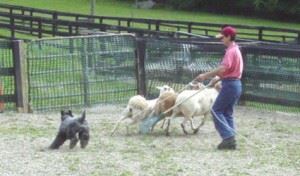 A couple of months ago the USKBTC website announced a herding clinic to be offered in early August in Pawling, NY. Having read that Kerries had been used in Ireland as herders, I was interested and decided to sign up our Kerry, Ch. Heritage The Artful Dodger, to see how he’d fare.
A couple of months ago the USKBTC website announced a herding clinic to be offered in early August in Pawling, NY. Having read that Kerries had been used in Ireland as herders, I was interested and decided to sign up our Kerry, Ch. Heritage The Artful Dodger, to see how he’d fare.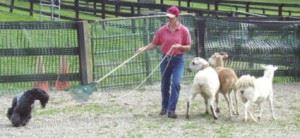
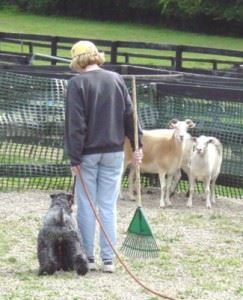 pen, in both directions, with the dog always on the rail; and “Walk up” – which involved bringing the dog in toward the sheep, but slowly, and under complete control. It was interesting to see how various dogs reacted. Some seemed like naturals, a couple were tentative and shy, one was unruly and one wasn’t very interested. What I liked was that Tenley was encouraging and positive with everyone, but at the same time she was very clear in her expectations.
pen, in both directions, with the dog always on the rail; and “Walk up” – which involved bringing the dog in toward the sheep, but slowly, and under complete control. It was interesting to see how various dogs reacted. Some seemed like naturals, a couple were tentative and shy, one was unruly and one wasn’t very interested. What I liked was that Tenley was encouraging and positive with everyone, but at the same time she was very clear in her expectations.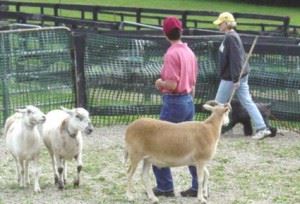 After about 10 minutes it was her turn to work with him alone, and I stood by the rail and watched. The short version of all this is that he did very well. Having never in his life seen sheep, he didn’t know what to expect. Tenley, whose sensitivity to each dog’s personality was really impressive, pointed out to everyone that he was clearly trying to communicate to the sheep that they should be afraid of him! She added, “He doesn’t know this yet, of course, but they are already afraid of him – they’re afraid of everything!” He caught on really quickly and within a few minutes was doing just what she wanted him to do.
After about 10 minutes it was her turn to work with him alone, and I stood by the rail and watched. The short version of all this is that he did very well. Having never in his life seen sheep, he didn’t know what to expect. Tenley, whose sensitivity to each dog’s personality was really impressive, pointed out to everyone that he was clearly trying to communicate to the sheep that they should be afraid of him! She added, “He doesn’t know this yet, of course, but they are already afraid of him – they’re afraid of everything!” He caught on really quickly and within a few minutes was doing just what she wanted him to do.